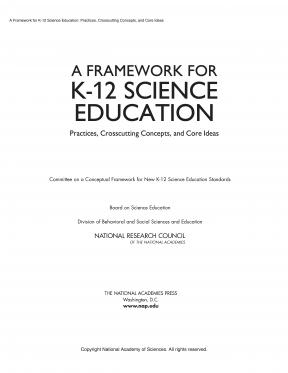A Framework for K-12 Science Education: Practices, Crosscutting Concepts, and Core Ideas
This framework identifies the key scientific ideas and practices adults should have to engage in public discussions on science-related issues, be careful consumers of scientific and technical information, and enter the careers of their choice.
A Framework for K-12 Science Education proposes a new approach to science education to capture students' interest and provide them with the necessary foundational knowledge in the field. The framework is designed to make science education more closely resemble the way scientists work and think and envisions that students will gradually deepen their understanding of scientific ideas over time by engaging in practices that scientists and engineers actually use.
Adult educators will find the framework useful in that it identifies the key scientific ideas and practices that students should learn by the end of high school. The framework was the foundation for two LINCS science courses that introduce adult instructors to the importance of science education, curriculum planning, and the use of science in adults’ daily lives:
- Engaging Adult Learners in Science
- Scientific Practices in Context: Curricular Planning and Lesson Development
The framework organizes the key scientific ideas and practices under three dimensions:
Dimension 1: Scientific and Engineering Practices. The framework highlights eight key practices that students should learn, such as asking questions and defining problems, analyzing and interpreting data, and constructing explanations and designing solutions. These practices should be integrated with study of the disciplinary core ideas and applied throughout students’ education.
Dimension 2: Crosscutting Concepts. The framework identifiesseven crosscutting concepts that have explanatory value across much of science and engineering, such as “cause and effect” and “stability and change.” These concepts should be taught in the context of core ideas from the disciplines of science but teachers should use a common language for these concepts across disciplines, so that students understand the same concept is relevant in many fields.
Dimension 3: Disciplinary Core Ideas. The framework specifies core ideas in four disciplinary areas -- life sciences; physical sciences; earth and space sciences; and engineering, technology and the applications of science. For example, among the core ideas in the physical sciences are “matter and its interactions” and “energy.”
The report concludes with a research and development agenda focused on teacher practice and curricular resources.
A Framework for K-12 Science Education builds upon more than 25 years of discussion and writing about the teaching and learning of science in America, in formal and informal settings. It is an immensely useful document, providing a structure for the implementation of its core principles and standards. This is especially true as it applies to the field of adult education, because it includes a section on how to implement seven cross-cutting concepts such as patterns; cause and effect; scale, proportion and quantity; and system models. These concepts are integral to the development of many skills and the concepts are directly applicable to educational needs evidenced by adult students who come to our programs.
The Guiding Assumptions and Organization of the Framework are particularly interesting summaries of learning theories and ideas that serve as the foundation of the report. Dimension 1 (Scientific and Engineering Practices) and Dimension 2 (Crosscutting Concepts) are also good foundational pieces for those who may be involved in creating standards for adult literacy or bridge/post secondary programs in science. Dimension 3 (Disciplinary Core Ideas) provides more detailed information on each of the four content areas.
This site includes links to information created by other public and private organizations. These links are provided for the user’s convenience. The U.S. Department of Education does not control or guarantee the accuracy, relevance, timeliness, or completeness of this non-ED information. The inclusion of these links is not intended to reflect their importance, nor is it intended to endorse views expressed, or products or services offered, on these non-ED sites.
Please note that privacy policies on non-ED sites may differ from ED’s privacy policy. When you visit lincs.ed.gov, no personal information is collected unless you choose to provide that information to us. We do not give, share, sell, or transfer any personal information to a third party. We recommend that you read the privacy policy of non-ED websites that you visit. We invite you to read our privacy policy.
